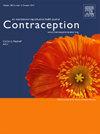在妊娠 22 至 24 周之间使用米非司酮进行扩张和排空人工流产手术的相关并发症
IF 2.8
2区 医学
Q1 OBSTETRICS & GYNECOLOGY
引用次数: 0
摘要
目的:扩张和排空是妊娠 20 周后最常见的程序性人工流产方法。充分扩张宫颈对安全扩张和排空至关重要。2017 年,英国妊娠咨询服务机构(BPAS)将米非司酮添加到渗透性扩张剂方案中,用于扩张和排空前的宫颈成熟。这项回顾性研究分析了与使用米非司酮进行宫颈成熟相关的并发症风险。方法英国妊娠咨询服务提供的数据包括2012年2月至2017年2月(仅使用渗透性扩张器)和2017年11月至2022年11月(米非司酮和渗透性扩张器)期间发生在妊娠22周至23周6天之间的扩张和排空手术。以时间作为米非司酮使用的替代指标,确定了米非司酮使用与扩张和排空并发症之间的关联。在控制潜在混杂因素的情况下,采用多变量逻辑回归法计算使用和未使用米非司酮的并发症发生几率。使用米非司酮的患者更有可能出现任何并发症(OR:2.40,95% CI:1.62,3.54)。他们出血的几率也更高(OR:3.08,95% CI:1.12,8.48)。宫颈损伤(OR:2.21,95% CI:0.84,5.80)和感染(OR:1.89,95% CI:0.46,7.69)的几率在使用和未使用米非司酮的患者之间没有差异。本文章由计算机程序翻译,如有差异,请以英文原文为准。
COMPLICATIONS ASSOCIATED WITH MIFEPRISTONE USE FOR DILATION AND EVACUATION ABORTION PROCEDURES BETWEEN 22 AND 24 WEEKS’ GESTATION
Objectives
Dilation and evacuation is the most common method of procedural abortion after 20 weeks’ gestation. Adequate cervical dilation is essential for safe dilation and evacuation. In 2017, the British Pregnancy Advisory Service (BPAS) added mifepristone to their regimen of osmotic dilators for cervical ripening before dilation and evacuation. This retrospective study analyzed the risk for complications associated with the use of mifepristone for cervical ripening.
Methods
BPAS provided data which included dilation and evacuation procedures that occurred between 22 weeks’ and 23 weeks and 6 days’ gestation, between February 2012 and February 2017 (osmotic dilators only), and November 2017 to November 2022 (mifepristone and osmotic dilators). Using time as a proxy for mifepristone use, the association between mifepristone use and dilation and evacuation complications was established. Multivariate logistic regression was used to calculate the odds for complications with and without mifepristone use while controlling for potential confounders.
Results
There were 6,516 dilation and evacuation procedures at BPAS during this time. Those who received mifepristone were more likely to experience any complication (OR: 2.40, 95% CI: 1.62, 3.54). They also had higher odds of bleeding (OR: 3.08, 95% CI: 1.12, 8.48). Odds for cervical injury (OR: 2.21, 95% CI: 0.84, 5.80) and infection (OR: 1.89, 95% CI: 0.46, 7.69) were not different between those who did and did not receive mifepristone.
Conclusions
The addition of mifepristone to osmotic dilators was associated with an increase in the odds of complications of dilation and evacuation, without attenuating the risk of complications related to cervical dilation.
求助全文
通过发布文献求助,成功后即可免费获取论文全文。
去求助
来源期刊

Contraception
医学-妇产科学
CiteScore
4.70
自引率
17.20%
发文量
211
审稿时长
69 days
期刊介绍:
Contraception has an open access mirror journal Contraception: X, sharing the same aims and scope, editorial team, submission system and rigorous peer review.
The journal Contraception wishes to advance reproductive health through the rapid publication of the best and most interesting new scholarship regarding contraception and related fields such as abortion. The journal welcomes manuscripts from investigators working in the laboratory, clinical and social sciences, as well as public health and health professions education.
 求助内容:
求助内容: 应助结果提醒方式:
应助结果提醒方式:


